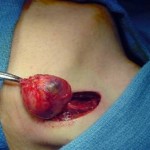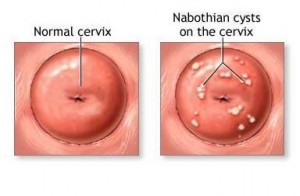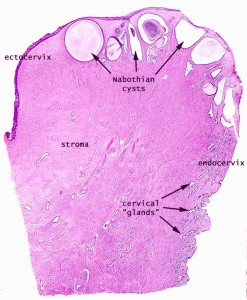What is Nabothian cyst?
Page Contents
- 1 What is Nabothian cyst?
- 2 Nabothian Cyst Causes
- 3 Nabothian Cyst Symptoms
- 4 Nabothian Cyst Diagnosis
- 5 Nabothian cyst Treatment
- 6 Nabothian Cyst Duration
- 7 Nabothian Cyst Prevention
- 8 When to contact a medical professional
- 9 Nabothian Cyst Possible Complications
- 10 Nabothian Cyst Prognosis
- 11 Nabothian Cyst Pictures
Nabothian cyst is lumps or cyst filled with mucus that grows on the cervical surface. It is normally 2 to 10 millimeters in diameter and consists of mucus that is amber yellow or pale yellow in color.
Generally Nabothian cyst is formed with the re-growth of new tissue on cervix after childbirth. The new tissue closes the openings of the Nabothian glands and traps their mucous discharge in tiny follicles under the skin. Nabothian cyst is frequently found on a woman’s cervix after childbirth. They are also sometimes found in menopausal women with thinning cervical skin. In some rare occasions, Nabothian cyst is connected to chronic cervicitis, a form of long term cervix infection.
Nabothian cyst is frequently referred to as epithelial inclusion cyst, Nabothian follicles and mucinous retention cyst.
Nabothian Cyst Causes
A woman’s cervix is lined with cells and glands that secrete mucus. The glands can get covered by certain skin cells known as squamous epithelium. This can result in the secretions getting accumulated on the cervix forming smooth, round bumps. These bumps are called Nabothian cysts.
Nabothian Cyst Symptoms
Nabothian cyst appears as small-sized, white, raised bumps that can appear singly or in clusters. The cyst normally does not create any symptoms unless they become exceptionally large.
Nabothian Cyst Diagnosis
Nabothian cyst is mostly discovered by the health care provider during a routine pelvic exam. A small rounded lump or a collection of lumps is discovered on the cervix’s surface. The woman may also notice the cyst herself while inserting a cervical cap or a diaphragm, or when going through a cervix check up. Sometimes, a colposcopy exam may be necessary to distinguish these cysts from other similar bumps on the cervix’s surface. If the cysts have got an abnormal appearance, the doctor may choose to do a biopsy to check for the presence of mucus-producing cancer.
Nabothian cyst Treatment
Nabothian cysts are normally considered harmless and hence they do not require any treatment. The cysts generally go away automatically and in some very rare cases do they pose as a persistent threat. Some women find that these cysts appear and disappear in accordance to their monthly menstrual cycle.
Sometimes Nabothian cysts grow very large in their size and develop secondary symptoms. There are two well-known methods used to remove Nabothian cyst, namely Cryotherapy and Electrocautery. In Cryotherapy, the cyst is frozen using liquid nitrogen. The process of Electrocautery makes the use of a heated probe for destroying the cyst.
Nabothian Cyst Duration
Nabothian cysts are normally considered to be a long term condition. Some of the cysts might get bigger with time.
Nabothian Cyst Prevention
Nabothian cyst is considered a common occurrence for women after childbirth. There is no known ways to prevent the development of these cysts.
When to contact a medical professional
Since Nabothian cyst is quite normal and they do not have any observable symptoms, normally a woman having them is unaware of the fact that she is having them. However, it is advisable for a woman to visit her gynecologist for regular checkups, as these cysts are normally detected during routine pelvic examinations.
Nabothian Cyst Possible Complications
Nabothian cyst can sometimes become so big in size that they can enlarge or block the cervix and make it difficult to conduct a Pap smear test.
Nabothian cyst may bleed if they are tampered with.
Nabothian Cyst Prognosis
Nabothian cyst is not known to cause any harm to the patient; they is in fact a benign condition. However, sometimes new cyst can develop even after the old ones are removed by Cryotherapy or Electrocautery.
Nabothian Cyst Pictures
Here are some images that show the growth of the Nabothian cyst on the cervix.

Picture 2 – Nabothian Cyst Image

Picture 3 – Nabothian Cyst Photo
Nabothian cyst is a benign condition that can be easily dealt with when diagnosed early. These cysts do not normally pose as a serious threat.
References:
http://www.ncbi.nlm.nih.gov/pubmedhealth/PMH0002482/
http://en.wikipedia.org/wiki/Nabothian_cyst
http://health.nytimes.com/health/guides/disease/nabothian-cyst/overview.html
http://www.drugs.com/health-guide/nabothian-cyst.html

